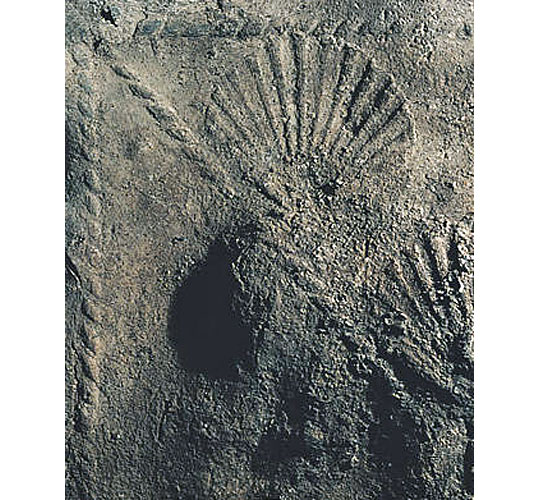Research on Lullingstone Roman Villa
The main body of knowledge regarding the Roman phases of the site derives from the 1949–61 excavations directed by GW Meates, E Greenfield and E Birchenough.[1]

Recent Surveys
Crucial additional information derives from a non-invasive survey of the site by DS Neal in 1983, which allowed the site sequence and phasing to be reconsidered and refined,[2] along with other information deriving from work in advance of sewer laying in 1986, including evidence of a number of Roman-period pits and ditches north of the villa-house.[3]
In 2006 work carried out in the site car park revealed a layer of soil that probably survives from the Roman period.[4]
In 2007 geophysical surveys (magnetometry, earth resistance and ground penetrating radar) were undertaken of the area immediately east of the villa cover-building, either side of access road to Lullingstone Castle and to the west of the villa car-park. These surveys were undertaken by Archaeological Surveys Ltd and Arrow Geophysics for English Heritage.[5]
Research Gaps
Areas where additional information and research would be helpful include:
- The character of the ‘South Outbuilding’, which was only seen by Meates during salvage recording during the construction of the villa cover-building.
- Further characterisation of the northern range, the function(s) and sequence of which are not clear from Meates’s report.
- Investigation of the immediate surrounding area to establish if there are further Roman structures that might clarify whether the site is more akin to a conventional 'villa-farm' complex. This could include investigation of the high-resistance features reported in the 2007 survey[6] west of the villa car park. These could relate to the villa, or provide evidence of medieval Lullingstone.
- The location of evidence, if any, for a jetty or other riverside structures possibly associated with the use of the river for transport.
- Evidence of buildings pre-dating the granary that would be necessary for the operation of the site as either a ‘country retreat’ for the provincial Governor, or as a working farm.
- Associations and parallels for the mosaics and the final form of the villa-house. The Lullingstone pavements are the only fourth-century mosaics known from Kent and are not easily paralleled in Britain; DJ Smith has suggested continental parallels for aspects of the house plan.[7] The possible Gnostic elements identified by Perring[8] that indicate that there are issues not only regarding the relationship of paganism and Christianity, but also with regard to the nature of the Christian belief represented.
- The location of a cemetery or cemeteries associated with the villa – the burials in the temple-mausoleum are exceptional and do not appear to have acted as a focus for other Roman-period burials.[9]
- The nature of the pre-villa occupation and use of the site.
- Secure dating evidence for major structural features.
The last two issues are difficult to advance given that they would require removal of in situ structural remains, although the first might be elucidated by investigations of the wider surrounding area.
Footnotes
1. GW Meates, The Lullingstone Roman Villa, Volume I: The Site, Monograph Series of the Kent Archaeological Society, 1 (Maidstone, 1979); GW Meates, The Lullingstone Roman Villa, Volume II: The Wall Paintings and Finds, Monograph Series of the Kent Archaeological Society, 3 (Maidstone, 1987).
2. DS Neal, Lullingstone Roman Villa: A Reappraisal of its Architectural Sequence (forthcoming).
3. Areas in English Heritage ownership: P Wilson, ‘Excavations at Lullingstone Roman Villa and Richborough Castle’, Kent Archaeological Society Newsletter, 10 (1986), 6. Areas outside English Heritage ownership: B Philp and M Chenery, ‘The Lullingstone Roman Villa Site, 1986’, in Lullingstone and Shoreham: Discoveries at the Roman Villa Sites 1982–6, ed B Philp and M Chenery, Kent Special Subject series 16 (2006, unpaginated). Contra Philp and Chenery (op cit, ‘4: The Wooden Stakes from the Villa Area’) it is highly unlikely that the ‘wooden stakes’ recovered by Kent Archaeological Rescue Unit from spoil dumped by the sewer-laying contractors were of any archaeological significance, but rather material derived from the infilling of what is now the site car-park area during clearance in advance of the 1949–61 excavations. Philp and Chenery (op cit, ‘Discussion’) make reference to ‘a large fragment of Roman wall in the backfill of the 19th-century sewer trench 100m north of the villa’.
4. A Ward, ‘An Archaeological Watching Brief at Lullingstone Roman Villa, Lullingstone, Kent’ (unpublished report, 2006).
5. T Archer, K Donaldson and D Sabin, ‘Multi-Technique Geophysical Survey at Lullingstone Roman Villa in Kent’, Archaeological Surveys Ltd and Arrow Geophysics (unpublished report, 2007).
6. Ibid, figs 8 and 9.
7. DJ Smith, ‘Regional aspects of the winged corridor villa in Britain’, in Studies in the Romano-British Villa, ed M Todd (Leicester, 1978), 124.
8. D Perring, The Roman House in Britain (London, 2002), 137.
9. In 1982 a 2nd-century cremation burial was found by a badger at TQ 519638 and excavated by Kent Archaeological Rescue Unit (B Philp, ‘Lullingstone – Badger Finds Roman Burial’, Kent Archaeological Review, 80, 1985, 245–6). Given the location is about a mile from the villa site, it is likely, as Philp suggests, to relate to another settlement.
